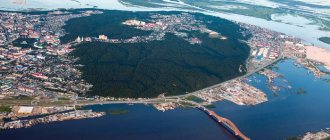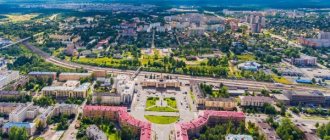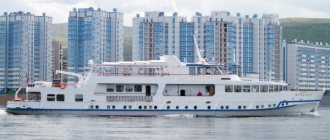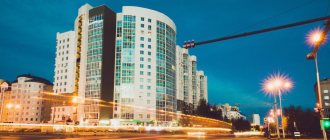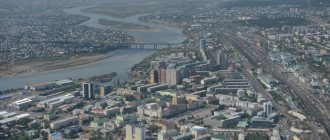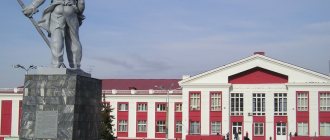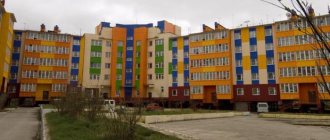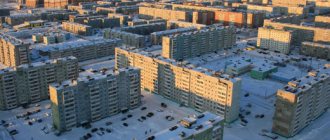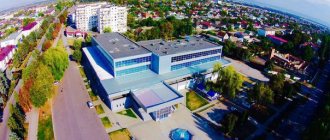A little about Magnitogorsk
Magnitogorsk on the map of Russia is geographically located on the slopes of the Southern Urals, near Magnitnaya Mountain, and is part of the Chelyabinsk region. The city is divided into 2 parts by the Ural River.
Large industrial enterprises are located on the left bank (in Asia), while the right bank (Europe) is built up with residential areas. The urban population is more than 418 thousand people, most of whom are Russians (over 80%).
The climate of Magnitogorsk is significantly influenced by the Ural Mountains, which block the flow of warm Atlantic air masses. Because of this, the city is exposed to cold Arctic air currents. The sharply continental climate is characterized by cold winters with little precipitation and severe frosts, and hot, dry summers.
Due to the harsh winter, the peak of tourist activity occurs in the warmest and driest months - from May to July inclusive.
University Square
Address: Russia, Chelyabinsk region, Magnitogorsk, 23rd quarter, University Square
Near MSTU. G.I. Nosov several years ago opened a park dedicated to the student construction team of Magnitogorsk. There is also a memorial sign in honor of all student groups in the city.
On the day of the grand opening of the composition and the square, a “Time Capsule” , which contains a message to descendants. It will be opened only in distant 2040, when the student movement of Magnitogorsk turns 75 years old.
Students often walk in the Student Square after classes, and various events organized by students are also held here.
How to get to Magnitogorsk
Magnitogorsk on the map of Russia is located relatively far from the capital, and the straight line distance is about 1400 km.
You can get to the city from Moscow both by land and by air:
| Way to travel | Travel time, hours | pros | Minuses |
| Airplane | 2,5 |
|
|
| Bus | 22 |
|
|
| Train | 34 |
|
|
| Automobile | 30 (25 non-stop) |
|
|
Literary Square
Address: Magnitogorsk, Literary Square
On Suvorov Street there is a small square called “Literary”. Nobody knows why it was given such a name, but that is what the residents of Magnitogorsk call it.
On the territory of the small park there is a children's playground, a sports area with horizontal bars and exercise equipment, and there is also a volleyball court.
All areas of the park are connected by well-maintained paths. There is also a fountain made of stone in “Literary”, but due to problems with the pipeline it no longer works.
Where to stay in Magnitogorsk
The city's hotel business is aimed at business travelers from other cities, foreign representatives of enterprises and athletes who come to any annual sporting events.
There are relatively few tourists in Magnitogorsk, and it is visited mainly by people vacationing at nearby resorts. Therefore, most hotels in the city are designed for the average income level.
The most popular and most comfortable hotels for tourists are:
- Europe 4* – the cost of a standard single room is 4.2 thousand rubles. A buffet breakfast is also included. The hotel has parking, a conference room, a tennis court, a sauna and billiards. The hotel is located in a fairly quiet and cozy area of the Right Bank on the street. Green.
- Laguna 3* – the hotel is located in the city center on the street. Embankment, near the Ural River. Guests have the opportunity to visit the indoor swimming pool, SPA center, and solarium. The cost for single occupancy is 3.8 thousand rubles, including breakfast.
- Forum 3* – the hotel is located in the central part of the city on Lenin Avenue. The average cost for single occupancy is about 3 – 4 thousand rubles. It includes a buffet breakfast. The hotel has a sauna, karaoke room and fitness center.
The cost of hotels with a lower star rating varies from 1 thousand rubles. per day, and a hostel can be found at a price of 500 rubles. per person. The hotels are located on the right bank of the Urals, closer to the central part of the city.
Districts and real estate of Magnitogorsk: which coast is better to live on?
Strict geographers and cartographers divide Magnitogorsk into 3 administrative districts: Leninsky, Ordzhonikidze and Pravoberezhny. However, local residents in most cases prefer a simpler division - Right Bank and Left Bank. The fact is that the famous Ural River flowing through the city divides it into two unequal parts: the “working quarters” of the Left Bank and the more respectable Right Bank. These parts of the city are connected by three bridges, called the Southern Passage, the Central Passage and the Cossack Crossing.
Magnitogorsk map
It is along the Urals that the geographical border between Asia and Europe passes. So, while living in Magnitogorsk, you can regularly travel from one part of the world to another. Signs "Europe - Asia" are located in the center of each of the bridges. Under it you can often find city guests taking pictures. The locals are already quite indifferent to this cute feature of Magnitogorsk – they’ve gotten used to it.
Europe Asia
Local residents are more concerned about the environmental situation in the city. As mentioned above, Magnitka occupies the top positions in the not very honorable ranking of the most environmentally disadvantaged settlements. The work of the giant MMK and its subsidiaries - calibration, hardware and other plants - is to blame. Therefore, the industrial Left Bank (or rather the left bank part of the Ordzhonikidze and Leninsky districts) is considered not the best place for housing.
So apartments and rooms can be purchased quite cheaply here. The average cost of a left-bank “kopeck piece” is from 1,200,000 to 1,600,000 rubles (depending on the area, layout and condition of the living space). Renting a room will cost 3-4 thousand per month, and it is quite possible to rent a small apartment for the same period for 8-12 thousand rubles.
Housing on the Left Bank
The “Asian” Left Bank arose on the site of a workers’ settlement created in 1929 for the construction and subsequent maintenance of the Magnitogorsk Iron and Steel Works. Barracks were built for the enthusiasts who came to build the MMK. With the development of the city, major housing development was organized here, starting with Pionerskaya Street. Despite the fact that these houses have gone through more than one major renovation, their spacious and comfortable apartments are in great demand among Magnitogorsk residents. However, some housewives claim that the kitchens here could have been larger.
Currently, representatives of the working class live in this part of the city, working at MMK and attracted by the relatively low cost of housing. Young families with average and low incomes often rent or buy apartments here. Marginal individuals often find themselves on the Left Bank, having received a room or a tiny apartment as a result of a series of transactions for the sale of more prestigious living space.
Typical house on the Left Bank
It is worth noting that the local Stalinist and Khrushchev buildings are already pretty battered by life and most of them require serious repairs. The unfavorable ecological situation of the Left Bank also affects their appearance. Even surprisingly beautiful examples of the Stalinist Empire style became covered with untidy black stains over time. However, apartments in such houses often turn out to be very, very good: with large square footage and high ceilings. And in many courtyards, children’s playgrounds have been installed to the delight of children and their parents.
A number of houses in the area fall under the relocation programme. The fact is that these buildings are located in particularly unfavorable places and living in them, according to city authorities and Magnitogorsk environmentalists, can cause serious harm to people’s health. As a result, driving along the left bank, you can see empty houses (for example, two-story buildings in the area of the City Theater and on Pionerskaya). Their residents have already been resettled to other, more prosperous areas. Such abandoned houses often serve as a refuge for antisocial elements and groups of teenagers.
House on Pionerskaya Street
Entry to Magnitka from the left bank is through the private sector. For the most part, these are ordinary modest houses with tiny plots of land. Some of the local residents even manage to maintain small farms. Away from the main streets, you can even stumble upon free-roaming chickens or geese. However, you can also see modern two- and three-story cottages here, but this is the exception rather than the rule.
In the “Asian” part of the Ordzhonikidze district there are many small heterogeneous villages with individual buildings. Mostly representatives of the middle class settle here, having managed to save up a more or less decent amount to build their own home. The most prestigious are the sleeper houses located in the southern part of Magnitka, closer to the Ural River. Other villages on the left bank mainly consist of panel houses.
In recent years, many truly respectable villages have appeared on the right bank of the Urals (the village of Magnitnaya, etc.). Private three- and four-story cottages are being built here. And in the southern tip of the “European” part of the Ordzhonikidze district, the local Rublyovka even appeared. This is the village of Khutorki, popularly called the “Tsar’s Village”. This is where most of the Magnitogorsk elite live: successful businessmen, some MMK managers, “notable” hockey players and other well-known personalities in the city.
The cost of a “house” on Magnitogorsk Rublyovka is off the charts, not just thousands, but millions of rubles. On the Internet you can find advertisements for the sale of a three- or four-story cottage for both 12 and 40 “lemons.” However, such an acquisition is considered a very profitable investment. After all, this is not just living space, but a kind of passport to the world of the rich and famous.
House on Khutorki
However, “mere mortals” live quite comfortably in the right-bank “European” part of the Ordzhonikidze district. Mostly there are panel houses from the Brezhnev era. The apartments in them have an improved layout (compared to Khrushchev buildings, of course), and therefore a higher cost. The price of apartments is significantly affected by the distance from MMK. Therefore, for housing with an area of 60-70 square meters they ask for 1.5-1.7 million rubles and more, but an apartment in an elite new building can cost 3-4 times more.
Housing in Pravoberezhny district
As you might guess, real estate prices in the Pravoberezhny district are even higher. Firstly, residential areas located on the right bank of the Urals are located in a relatively favorable ecological zone. And secondly, this is the real center of business and administrative life of the city with a well-developed infrastructure. This is where the city administration, branches of large commercial banks, communications enterprises and design institutes are located.
This is the central area of the city, occupying a fairly large area. Its borders lie between the park area of the Ural coast and Sovetskaya Street (from the Drama Theater to the Cossack crossing). The architecture of administrative and other “public” buildings is very original. For the interior decoration of many of them, marble, granite, openwork cast iron parts and even jasper were used.
Residential buildings in the Pravoberezhny district are mainly represented by standard panel and block Khrushchev buildings, similar to each other like twin brothers. At one time, their appearance helped to at least partially solve the housing problem that was particularly acute at that time.
In theory, the narrow streets of the area (except for the central highways - Lenin Avenue and Karl Marx Street), clogged courtyards and the not very attractive appearance of the houses should be factors reducing the cost of apartments. However, housing in the Pravoberezhny district is not cheap at all (on average 30-35 thousand rubles per square meter). The center is the center. If you wish, you can find fairly cheap housing here. True, it will be a tiny one-room apartment in a small family with a small kitchen, a combined bathroom and a sit-down bathtub.
Lenin Avenue
But it is unlikely that you will be able to save money on buying housing in the right bank block No. 14 “a” (this is the Leninsky district of Magnitka). The houses that make up it were built after 1945 by German prisoners of war and are considered real architectural monuments. The architecture of the quarter contains Western European motifs, and its interior space is represented by small closed courtyards. This block has its own composition: the houses in it are built relative to a planning axis, starting from the central arch of a two-story residential building on the street. Uralskaya, 36 and smoothly descending towards the Ural River.
All the houses in the block are two-story (the builders were required to put living space into operation as quickly as possible), and the materials for them were slag concrete and flagstone. From Uralskaya Street you can get here through wide gates with patterned metal bars. The houses themselves are decorated with patches of flagstone, small balconies and other interesting elements. So the desire to live in the “German Courtyards” will be quite expensive.
Magnitogorsk German town
The most expensive housing in Magnitka is located in the blocks of the “European” Leninsky district. The so-called Stalin buildings (houses built in the pompous “Stalinist Empire” style) predominate here. Architects used turrets, niches, colonnades and portals as decorative elements for them. Many of the buildings have front entrances, and the apartments here have a convenient layout, large area and significant ceiling heights. The northern part of Leningradskaya Street (formerly Zhdanova Street) is considered one of the architectural landmarks of the area.
Leningradskaya street
From the windows of many houses here, the smokestacks of the Left Bank are clearly visible. However, the abundance of all kinds of squares, gardens, front gardens, boulevards and green courtyards partially helps to compensate for the not entirely favorable environmental situation associated with the relative proximity of the MMK (about a kilometer).
Proximity to the center, original architecture, cozy streets and abundance of greenery make housing in the Leninsky district especially attractive. Naturally, increased demand could not but affect the cost of local apartments. The cost of 1 square meter of living space here is significantly higher than the average level of Magnitogorsk real estate prices.
Where to eat in Magnitogorsk
Magnitogorsk cuisine, like the cuisines of other regions on the map of Russia, has its own distinctive features and special recipes, formed under the influence of the cultures and traditions of different peoples.
Traditional dishes of the Urals combine the features of Tatar, Asian, Kazakh and original Russian cuisines. Residents of the Urals prefer all kinds of flour dishes - be it meat pies or sweet pastries. Of course, everyone knows the Ural dumplings. But traditionally this dish was prepared not with meat, but with vegetable filling.
Liquid dishes are prepared thick and rich. And in general, the entire cuisine of the Urals is very filling and high in calories. This is the kind of food you want to eat in severe frosts. In addition, the main dishes include gifts of nature - local fish, forest mushrooms and berries. Bird cherry fruits are popular, from which delicious preserves and jams are prepared, as well as bird cherry flour for baking sweets.
Tourists can taste both native Russian dishes and dishes of Japanese, European and Italian cuisines.
There are quite a lot of establishments in the city to suit every taste and budget:
- Russian estate is a restaurant on the outskirts of the city, located on the highway. Western. Despite the distance from the center, it is in great demand. It is located in a quiet place, surrounded by nature, and its external and internal interior is made in the old Russian style like a log hut.
- Uchkuduk is an oriental-style restaurant located in the central part of the city on the street. Oktyabrskaya. This colorful establishment with a beautiful interior includes no less interesting dishes of Eastern European cuisine on its menu.
- Dikanka – a restaurant of Ukrainian cuisine in the city center on the street. Komsomolskaya. The menu features traditional Ukrainian dishes, and the portions are large and filling for a reasonable fee. The establishment is popular not only among local residents, but also among tourists.
Popular budget restaurants include Galushka, Bufet and Koff-Chic, as well as chain restaurants and fast food cafes.
Architectural landmarks
Magnitogorsk is a city that was not built up chaotically and gradually (like most Russian cities), but grew and expanded according to a plan thought out in advance. That’s why the buildings on many streets are lined up like a ruler.
Leningrad architects took part in creating the modern architectural appearance of the city, so in many buildings in Magnitogorsk you can find familiar features of St. Petersburg ensembles: columns, turrets, porticos are in harmony with the strict facades of the buildings.
- Chimes is a city 29-meter rectangular tower with a clock, built in the very center of Magnitogorsk, on the People's Festival Square. The tower was erected in honor of the city’s 50th anniversary in 1979. Since then, it has become an iconic meeting and dating place.
- German quarter - this is the name of block 14-a in the old part of the city, in the Leninsky district. The houses are finished with gray stone, and the facades are decorated with arches and miniature open balconies, which are not typical for Russia.
The height of the houses does not exceed 2 - 3 floors, creating the impression of a residential area in some Western European city. The quarter was built by German prisoners captured during the Great Patriotic War, and, according to the idea of the Soviet government, it was supposed to become a visual symbol of Russia's victory. - The Opera and Ballet Theater is a classical-style building with a colonnade along the central facade. The theater was opened in 1996. The interior includes 2 halls, and the repertoire is designed not only for adults, but also for children.
- Metallurgov Avenue , the calling card of the city, is a wide street with buildings in the same architectural style of Stalin times. The street was built up in the 50s. XX century, and the beautiful facades of buildings with bay windows, arches and balconies give it a cozy and festive look. On the territory of the avenue there is a small city square and Arbat, where local artists and performers can express their talents.
- Ice Arena – located on Lenin Ave., near the city center. Magnitogorsk became famous for its hockey team “Metallurg”, which is part of the KHL, so the ice palace was named “Arena-Metallurg”.
Since its opening in 2007, it has served not only as a sports ground, but also for hosting all kinds of entertainment events and concerts. There are no special excursions to the legendary Arena, but you can attend a hockey match by purchasing an inexpensive ticket.
Monuments
Magnitogorsk on the map of Russia, although it has the status of an industrial city, attracts tourists with many different attractions, among which interesting monuments occupy a special place.
Many of them are dedicated to the first settlers of Magnitogorsk, who came to mine ore, and to the iron ore itself, thanks to which the city was built. During the war, it was from Magnitogorsk ore that the majority of military shells and tanks were produced.
- The First Builders' Tent is a federal monument depicting a stone tent with a hand holding iron ore. It is located on the square. Sverdlova near Veterans Park, is one of the symbols of the city.
- Monument "Europe - Asia" - installed near the Central City Bridge and serves as a symbolic border between Asia and Europe, and on the bridge itself there is a similar road sign.
- The first steam locomotive is a real steam locomotive that delivered the first train to the future city of Magnitogorsk in 1929. 50 years later it was installed near the railway station as a monument on a concrete pedestal.
- Monument “Rear to Front” - a monument in the city center, on Lenin Ave. Consists of 2 sculptures - a worker who forged a sword, who gives it to a warrior. The warrior's face is directed to the western direction, where the front was previously located. The 15-meter monument has become one of the most recognizable symbols of the city.
- Metallurgist - forged from copper and is a statue of a metallurgical plant worker. Initially, he was part of the sculpture “Worker and Collective Farm Woman”, having visited several international exhibitions. And in 1967 it was transferred to Magnitogorsk. The monument is located near the railway station.
The city also has interesting monuments to parents, students, a janitor and plumber, and a blast furnace operator.
Religious sites
Magnitogorsk is a multinational city with quite a lot of Muslims living on its territory. Therefore, the religious sites of the city are represented not only by Orthodox churches, but also by mosques.
- Church of the Ascension of the Lord - a white stone temple on the banks of the Urals with 7 domes, 42 m high. It is located on the street. Voznesenskaya. Despite the fact that the cathedral was consecrated only in 2004, it is one of the most beautiful religious sites in the country. In front of the temple there is a statue of St. Simeon of Verkhoturye, and in its vicinity there is a house of mercy, a belfry, and a baptismal church.
- The Cathedral Mosque is a beautiful building located on the street. Gryaznova. The general architecture of the area surrounding the mosque is shaped like a crescent (utility building) with a star (mosque building). The mosque itself is built in the shape of a 9-pointed star and is a snow-white building with a dark dome. In the center of the crescent there is a minaret with a platform for the call to prayer. The mosque itself has 2 separate halls - for men and women.
History of the city
The founding date of the city is 1743. Initially it was a fortress village located on the banks of the Yaik River. As of 1759, this village consisted of 110 residential households and 300 inhabitants. It was in this year that iron ore deposits began to be developed. The first ore processing plant, called Beloretsky, was built in 1874. At this time, 2.5 thousand people worked there. The villages of Magnitny, Navarinsky, Chernigovsky, Yangelsky, Trebiatsky and the settlements of Verkhnekizilsky, Bobrykinsky, Smely in 1881 supplemented Magnitogorsk. No one probably remembers what region or region it was in those years, but it is known for sure that after the annexation of the listed settlements, the population increased to 10,000 people.
To establish a connection with Beloretsk, a railway was built in Magnitogorsk in 1915. 1929 was the year of construction of a metallurgical plant in the city, which turned Magnitogorsk into the center of metallurgy in the country. Beginning in 1932, the city had its first school, pedagogical institute, theater, airstrip, several tram lines, a cement plant and a music school. In 1940, the city's population was 147 thousand inhabitants. The 50s became a period of expansion of Magnitogorsk - its area increased significantly, many new residential buildings were erected.
Museums
There are several museums in Magnitogorsk that will introduce guests to the history and culture of the city, the features of its development:
- Museum of Local Lore - the very first museum of the city, which includes in its collection not only historical and cultural exhibits, but also scientific exhibits from the field of geology and biology. The museum was founded in 1944, and during the history of its existence it has repeatedly moved from one building to another. At the moment it is located on the street. Soviet army.
- Museum of the Metallurgical Plant - opened in 1973 and is located on Pushkin Avenue. The museum contains a collection of exhibits telling about the history and stages of development of the metallurgical industry. Here there is a visual model of the Metallurgical Plant, with all its workshops and plants. A special place is occupied by a military exhibition dedicated to the life and history of those times, including exhibits of military equipment and weapons made from Magnitogorsk ore.
- Art gallery – located on the street. Newspapers Pravda. The museum's collection includes more than 7 thousand exhibits, including rare and unique pieces of art. The creation of the gallery was conceived along with the formation of the city, and the collection dates back to the 1930s. The gallery periodically hosts cultural festivals, exhibitions of contemporary art, all kinds of seminars and meetings.
Geography of the city
Regardless of whether a person has heard or not about a city like Magnitogorsk, what region it is, few can say. After all, attention is usually focused on other features of the city, of which there are many. Many even think that the Magnitogorsk region exists, but this is not so.
In fact, the city belongs to the Chelyabinsk region and is located in its southwestern part, near the border of Bashkiria. 370 square kilometers - this is exactly the area occupied by the city of Magnitogorsk. Which region - you already know, all that remains is to add that administratively the city is divided into 3 districts - Pravoberezhny, Leninsky and Ordzhonikidze.
The most interesting and unusual places in Magnitogorsk
In the city and its surroundings there are quite interesting and popular places among tourists that are worth visiting:
- Magnitogorsk Iron and Steel Works is a journey through the main production workshops of the steel vein in Russia, where you can get acquainted in detail with the process of mining and processing of ore, evaluate its scale and compare with your own eyes the industrial workshops with a model in the metallurgy museum.
- Happy Alley – one of the most unusual places in the city, popular not only among tourists, but also local residents. The alley opened in 2014, in the park named after. Romazana.
It consists of 14 original shops, each of which is decorated in an original style and is dedicated to one or another desire, which, according to the developers, leads to real happiness. There are benches dedicated to love, fidelity, frankness, children, and longevity. It is believed that if you sit on the right bench, a person will definitely get what he wants. - Bath Lake is located 50 km from the city, not far from the popular ski resort Metallurg - Magnitogorsk. On the outskirts of a quiet and picturesque area, on the shore of the lake, there are many recreation centers and sanatoriums offering not only a good time in nature, but also improved health.
Peace Square (Square named after M.Yu. Lermontov)
Address: Russia, Chelyabinsk region, Magnitogorsk, park named after M.Yu. Lermontov
Peace Square is one of the most cozy and beautiful places in Magnitogorsk. A quiet and peaceful place with many trees, under which there are charming red benches.
A special feature of the park is the monument to the famous poet M.Yu. Lermontov. The literary genius sits on a chair, holding an open book in one hand, the palm of the other on his knee, and looks down thoughtfully. Behind him stands a stele with the poet’s signatures and drawings.
At night, the park area is illuminated with bright colored lights, which gives this place a special atmosphere.
Where to go with a child in Magnitogorsk
Despite the industrial orientation, the city has a lot of entertainment for both adults and children.
The most suitable for family holidays are:
- Dancing fountains - a whole complex of fountains is located on the central square of Folk Festivals. In the evening, the beauty of the composition is complemented by lighting and classical musical compositions, which crowds of people gather to see.
- Ecological park - a green corner in the city center, offering all kinds of recreation for adults and children.
The eco-park in Magnitogorsk offers fresh air and entertainment for children and adults.
In the summer, the park has a fairy tale meadow and a playground, and provides all kinds of active sports recreation. In winter, ice skating rinks and slides open on its territory. The park is located on the street. Forest park, in the Pravoberezhny district. - Waterpark Waterfall of Miracles is the only water entertainment center in the Southern Urals with a capacity of up to 150 people. The water park is located on the street. Embankment, on an area of more than 2 hectares. It includes 3 restaurants, 4 slides, 5 attractions and 7 swimming pools.
- Dinosaur – a dino park on the shore of Lake Northern Ulyanda, located 27 km from Magnitogorsk. The park includes 28 life-size robotic dinosaur figures, tennis courts, a beach and food establishments.
- The city of cheerful shorties is an amusement park at the intersection of Lenin Ave. and st. Gryaznov, next to the city circus. The park has attractions for children and adults, and entertainment events are held.
Musical Square
Address: Russia, Chelyabinsk region, Magnitogorsk, Musical Square
In Magnitogorsk on the street. Labor, next to the Center for Aesthetic Education of Children, there is a very interesting and unusual square - Musical. Its special feature is musical instruments made of metal. Here you can see a piano, guitar, drums, accordion, saxophone and cello with music stand. The entrance to the park is decorated with a treble clef. All instruments are made to human height.
The territory of the park is decorated with perennial spruce trees that grow along the brick paths. For those who want to sit and admire the music. tools, benches were placed in a small park.
Night Magnitogorsk
The city has many clubs and bars open at night, not only on weekends, but also on weekdays. The entry price is quite affordable, and there are often 2-for-1 promotions. Alcoholic drinks also do not have a high price tag, and face control is quite loyal.
- Jaga-Jaga - one of the most popular establishments is located on the street. Embankment. This is an entire entertainment center, including a restaurant serving Serbian cuisine, a large dance floor and a bar. Russian stars often perform on the stage of the establishment.
- Universal - entertainment center on the street. Suvorov, which combines a nightclub, karaoke, bowling and billiards under its roof. The prices in the club are the most affordable, and the music is modern. Therefore, the main contingent of the establishment is young people.
- Sugar - club is located on the street. Even on ordinary days, Herzen is a cafe with cozy tables and a large bar. On Friday and Saturday, the establishment is open until the morning, turning into a nightclub where themed parties are often held and DJs from other cities are invited.
What to see in Magnitogorsk in 1 day
Magnitogorsk on the map of Russia has an elongated shape along the banks of the Urals, and its main attractions are located on the right bank of the river.
In 1 day you can get acquainted with the main attractions of the city, following the direction from the railway station to the south:
- Railway station – upon arrival in the city, it is worth looking at the famous monument to the Metallurgist and the First Steam Locomotive. Then go along Lenin Avenue past the Opera and Ballet Theater on the street. Uralskaya to Gorky Square, where the German Quarter is located.
- After admiring the houses of the German Quarter, you need to go south, where the city Avenue of Metallurgists is located.
- Further along Lenin Avenue you can go straight to the central Folk Festival Square, and on the way look into the museum of the poet B. Ruchyev and the Drama Theater named after. Pushkin.
- If you have time left, you can visit the park near the Eternal Flame, stroll along the alleys and look at the “Rear to Front” monument.
- It is better to see the Folk Festival Square in the evening, when you can see the Dancing Fountains in full glory, with music and lighting.
What to see in 2-3 days
If you have a little more time to explore the city’s sights, then the one-day itinerary should be slightly adjusted:
- From the train station you can head east to Veterans Park, where the First Builders Tent is located. Then see the German Quarter and other Metallurgists.
- From Metallurgov Avenue you can go east to the Central Passage, where the “Europe – Asia” monument with a sign is located.
- Once you find yourself on the other side, you should visit the Metallurgical Plant and look at the city from the observation deck.
- Afterwards, moving along Pushkin Avenue in a southern direction, go to the Museum of the Metallurgical Plant.
- Then along the street. Magnetic cross the river again. Finding yourself on the Right Bank, the beautiful Church of the Ascension of the Lord and the “Metallurg Arena” appear before your eyes.
- Moving north along Lenin Avenue, you can see the Museum of History and Local Lore, which you should visit to get acquainted with the history of the city.
- A little higher, on the street. Gryaznov, there is a beautiful building of the Cathedral Mosque.
- Slightly deviating from the route, moving west along the street. Gryaznov, you can go to the Ecological Park - a place of recreation and entertainment for children and adults.
- Returning back to the intersection of Lenin Ave. and st. Gryaznov, you should go north along Lenin Avenue to admire the clock tower, Dancing Fountains, visit the Art Gallery, the Ruchyev Museum, the Drama Theater and the park near the Eternal Flame.
Winter tourism
You can see the sights of the city at any time of the year, but many tourists prefer winter Magnitogorsk, since the Metallurg-Magnitogorsk ski resort is located 40 km from it.
Many Russian celebrities vacation here, and thanks to the presence of snow generators, skiing can be done from November to April. The resort is also called “Bannoye”, due to its location on the shores of Lake Bannoye.
Guests have at their disposal:
- professional inventory and equipment;
- instructor services;
- ice skating rink on the lake;
- 8 ski trails;
- 4 lifts (including children's);
- hotel and cafe.
30 km from the base (and 60 km from Magnitogorsk) there is a popular ski resort, repeatedly visited by V. Putin. It includes 13 slopes and 7 lifts, a snow park and freeride tracks.
The resort has more than 20 hotels and a recreation center of the same name, which
offers its visitors a visit to:
- baths and saunas;
- rental of cottages and picnic areas;
- hotel rooms;
- water park and entertainment center.
Both resorts can please guests not only with a variety of recreational activities, but also with affordable prices.
What to bring from Magnitogorsk
As a gift for relatives and friends from Magnitogorsk you can bring:
- Magnets and postcards with views of city attractions and surrounding areas.
- Souvenir porcelain plates and bells with landmarks.
- Jewelry and figurines made from local stones - onyx, jasper, agate.
- Souvenirs and clothing with the symbols of the Metallurg hockey club.
- Products from the Magnitka confectionery factory.
- Beer from local brewery "Hagel".
Despite the fact that Magnitogorsk is the industrial center of the Urals and the largest center of metallurgy on the map of Russia, it also plays the role of the cultural center of the Chelyabinsk region. The city has many interesting attractions, and the nearby popular resorts have made it famous not only among Russian tourists, but also among foreign travelers.
Author: Anna Lalochkina
Article design: Mila Friedan
City infrastructure or life in Magnitogorsk from the point of view of the average person
Residents of almost any city are always ready to complain about problems with roads, the quality of housing and communal services, the availability of places in kindergartens, and so on. Magnitogorsk is no exception in this regard. Citizens are often dissatisfied with both the congestion of the streets with vehicles and the quality of work of public utilities... However, some problems are being quite successfully resolved here.
Take, for example, the “road revolution” that thundered throughout the Southern Urals. It also affected Magnitogorsk. In 2010, after a visit from the regional governor, officials from the city hall quickly analyzed the condition of the roads and began repairing the most problematic areas. Over the past time, the road surface has been repaired on many streets (B. Ruchev, Gryaznov, 50th anniversary of Magnitka, etc.), and the capacity of Karl Marx Street has been slightly expanded.
However, one of the most pressing problems of Magnitogorsk remains overcrowding of the streets with transport. During the daytime, you can move around the city more or less calmly by car. But around 17:00, cars of metallurgical plant workers join the traffic flow. And this is where the “fun” begins. If you look closely, you can easily find that at this time two standard lanes of the road turn into three, or even four - motorists are doing their best to find an opportunity to get home faster.
During working hours, it is extremely difficult to drive through many of the MMK checkpoints. Despite the fact that there are parking lots for employees' cars, there is simply not enough space. Therefore, cars lined up in a long line along the side of the road are quite common here.
Many motorists often criticize the clumsy trams. From time to time there are rumors in the city that this type of transport will be replaced by cheaper and more convenient trolleybuses. It is worth noting that waiting for the right tram here can sometimes be very difficult. Especially on the Left Bank. Then the townspeople have to get to the center by minibuses. At the same time, there is always a good chance to meet an “extreme” driver who brakes in the most unexpected places and maneuvers in traffic in a way that simply takes the breath away of ordinary passengers.
How well are the communal services in Magnitogorsk? Compared to many other cities, tariffs for housing and communal services here are not too high. Electricity costs local residents 1,379 rubles. for 1 kWh, and for those who are especially economical, it is possible to install meters with day and night tariffs. But for organizations, a kilowatt costs a little more - 1.97 rubles. The payment “per meter” in residential premises depends on the degree of wear and tear of the building. Thus, residents of comfortable stone houses with up to 40% wear and tear pay 1.79 rubles per 1 m2. (+ maintenance of elevators, garbage chutes and solid waste removal). Water supply and sanitation in houses with complete amenities costs 79.72 and 124.49 rubles, respectively. per person. The average cost of heating services is 32.24 rubles. for 1 sq. meter of living space.
House of Peoples' Friendship
Unfortunately, the quality of utilities in many houses leaves much to be desired. Consumers often complain about the quality of water, its temperature and the ineffective operation of the heating system. In addition, residents of Magnitka have more than once faced the problem of water shortage in the city in the summer. For example, last year organizations were even set appropriate limits on consumption. It happened that the water supply to residential buildings was temporarily limited.
A big headache for Magnitogorsk architects is the unauthorized actions of residents to glaze balconies and loggias. Moreover, in each specific case, different materials and technologies are used, which does not have the best effect on the overall appearance of the building. The sad result of such actions may be the collapse of some decorative elements. For example, not long ago, a concrete flowerpot fell from the balcony of one of the houses in the Leninsky district, only by luck not injuring any passers-by. Many city residents believe that such collapses are also partly to blame for utility services, which do not monitor the condition of the house well.
Magnitka also lacks places in kindergartens. Experienced mothers get in line from the very birth of the baby. But this is not a guarantee that at one and a half to two years the child will already take his rightful place in the group. But the city has many early childhood development centers, swimming groups, sports clubs and art schools. Mostly such establishments are concentrated on the right bank, but residents of the Left Bank also have somewhere to send their children. And for adult Magnitogorsk residents, the city has all kinds of fitness clubs, dance schools, beauty salons, gyms and other entertainment and health facilities.
The health of small and large city residents is monitored by doctors from Magnitogorsk clinics. Despite the fact that the regional governor has ordered the elimination of queues in medical institutions, getting an appointment with the right specialist here can sometimes be problematic. A couple of years ago, the story of the transfer of the left bank children's clinic to the building of infectious diseases hospital No. 3 received wide resonance. Due to a thirty-year lack of repairs, the clinic building fell into almost complete disrepair, and at that time officials were unable to find new premises for it.
However, those who are not satisfied with the queues at clinics can safely make an appointment with a private specialist. Fortunately, there are plenty of commercial establishments of this kind in Magnitogorsk. These include dentists, diagnostic centers and even plastic surgery clinics. Many opticians employ qualified ophthalmologists. There is also a Family Medicine Center in the city.
